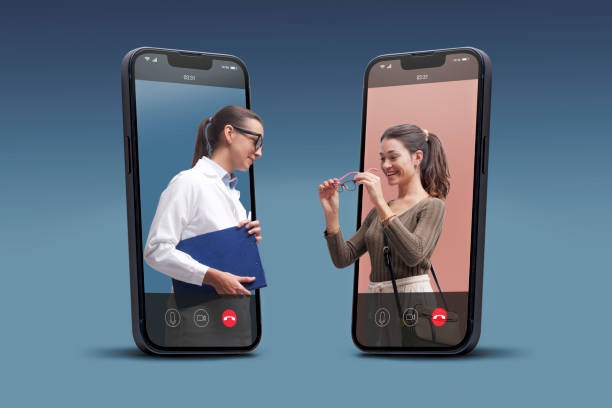
The increased use of technology such as medical imaging, artificial intelligence, and patient communication tools provides opportunities for private practices, universities, community health centers, management centers, and other optometric clinics to collaborate and provide quality care by working with other health care professionals in a changing world. This article will discuss how telehealth can improve access to high-quality vision care and most directly benefit our patients.1
A number of large companies have adopted telehealth to provide primary and specialty eye care. Artificial intelligence (AI) will likely impact every aspect of life in our global communities. For optometrists in private practice, universities, and community health centers, telehealth and AI present privacy and training challenges, but more importantly they provide ways to improve quality of care, efficiency, and patient satisfaction. Patient portals, call centers, and triage systems will continue to be patient- and technology-driven into the future. Optometric websites and mobile applications need to be updated regularly and integrated with telehealth and artificial intelligence. For the optometric profession to improve medical outcomes for communities, present telehealth technologies need to be embraced.
As an optometric educator I tell my students and residents that optometrists—and all clinicians—believe that we do a great job of educating our patients. However, if we really look in the mirror and are honest with ourselves, we know that our patients do not understand fundamental aspects of eye care (e.g., refractive eye care, cataracts, glaucoma, age-related macular degeneration, binocular vision). Patients forget and often rely on information about things such as conjunctivitis or astigmatism that they hear from friends and relatives and may be misleading. It is important for optometrists to upgrade our educational tools to improve patient scheduling, follow-up, informed consent, referrals, and comanagement.
Most optometric practices will always need business cards, appointment reminders, and patient instructions for Bruder masks, lid hygiene, eye drop installation, etc. However, smartphones, tablets, websites, patient portals, and other technologies are becoming more frequently used by patients. For many patients, AI can expedite proper appointment scheduling, patient education, and triage (conjunctivitis, hordeola, and other patient observations of both medical and cosmetic concern). The importance of educating and training support staff to treat patients with empathy is an ever-increasing challenge for clinical practices. Properly integrating AI can improve patient satisfaction by reducing misunderstandings and conflicts between staff and patients that occur in busy practices.
In 2022, the American Optometric Association developed its telemedicine in optometry policy statement, which was approved by its board of trustees.2 Input came from leaders and practicing physicians in eye care, health care, AI, and telehealth platforms. Criteria were developed and discussed to maintain high-quality patient care, as well as organization, training, and implementation for clinicians. Regulatory challenges continue to exist, such as scope of practice laws for affiliates, states, and other jurisdictions.
Clinical applications of optometric health include screening, patient triage, patient consultations, optometry and ophthalmology consultations, staff and technician training, education of optometrists, remote procedure supervision, and medical imaging consults. The use of smartphones and tablets to obtain medical images is commonplace in optometry, medicine, and dentistry. However, security and privacy issues should not be ignored or diminished as technology—especially autonomous AI—systems develop.
What are some optometric telehealth vitals that can be stored on a patient’s smartphone? They include as follows:
» visual acuity,
» visual fields,
» color vision,
» refractive error,
» fundus photography,
» optical coherence tomography (OCT),
» refractive error,
» pupil testing,
» IOP,
» corneal topography,
» meibomian gland imaging,
» prescriptions (spectacles and contact lens information),
» wavefront aberrometry, and
» corneal hysteresis.
Telehealth in optometric education
Optometrists and other clinicians will always compare new technologies with what they were taught in their optometric or medical education. Our optometric education, including residency training, board certification, and continuing education includes criterion standards that are always being refined. I contend that telehealth needs to be an integral part of future optometric education programs. These programs should involve case-based presentations and discussions. How do clinicians improve their diagnostic and clinical skills? Telehealth can provide ways to consult with other optometrists and clinicians to verify diagnoses and collaborate on proper treatment plans.
What can AI tell us when it analyzes patient data? What technology do we use to diagnose retinal disease, glaucoma, age-related macular degeneration, anterior segment disease, and refractive conditions? Let us consider the 2 telehealth categories:
1 Asynchronous telehealth is used for patient intake or in follow-up care. For example, a patient sends a photo of a conjunctival lesion that is later reviewed by an optometrist who determines a differential diagnosis and a management plan, such as medication and/or removal.1
2 Synchronous telehealth is an “interactive video transmission in both directions during the same time period.”3 Synchronous telehealth—or virtual visits—enables detailed patient-optometrist communication, leading to a collaborative treatment plan as well as proper patient education. For example, a patient is examined via anterior segment photography video, and the images are streamed by video to the optometrist in real time.3
These telehealth categories can be invaluable in-patient triage, treatment, and education. High-definition pictures and videos represent important components of electronic health records and better ways of monitoring ocular disease and other conditions. Furthermore, the use of high-quality medical imaging is a powerful way of educating patients and improving adherence with treatment and management plans.
Summary
The technology used in the practice of optometry is well established. It includes medical imaging, visual fields, autorefraction, wavefront aberrometry, OCTs and OCT angiography, corneal topography, tonometry, and smartphone adapters.
One of the biggest challenges that optometrists encounter is the proper booking of their slots for optimal patient and workflow. While there are many challenges to make sure these telehealth exams and visits provide high-quality care to our patients and diverse communities, integrating telehealth into optometric education both in optometry school curricula and continuing education will be important in the acceptance and adoption of telehealth by clinical optometrists.